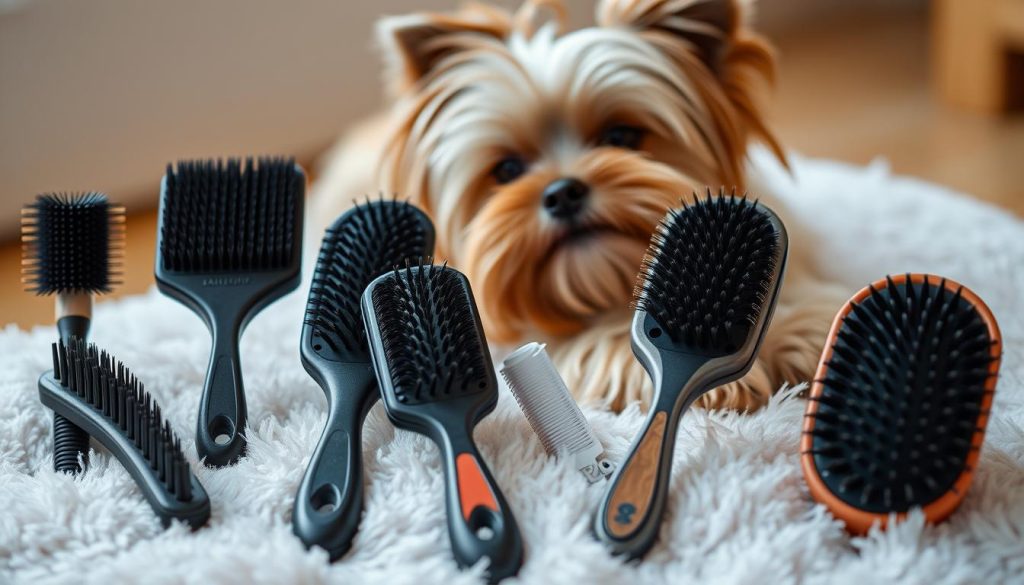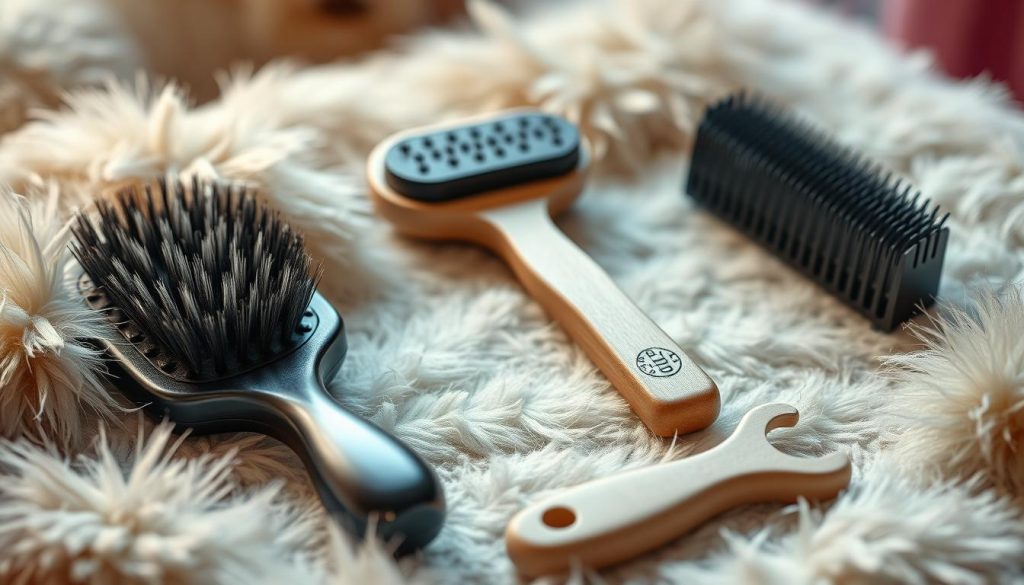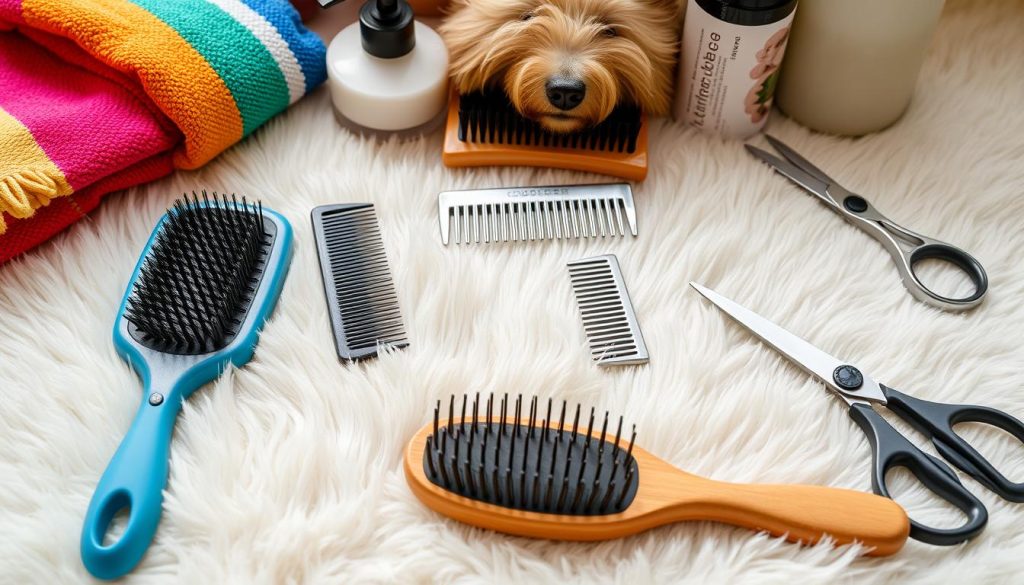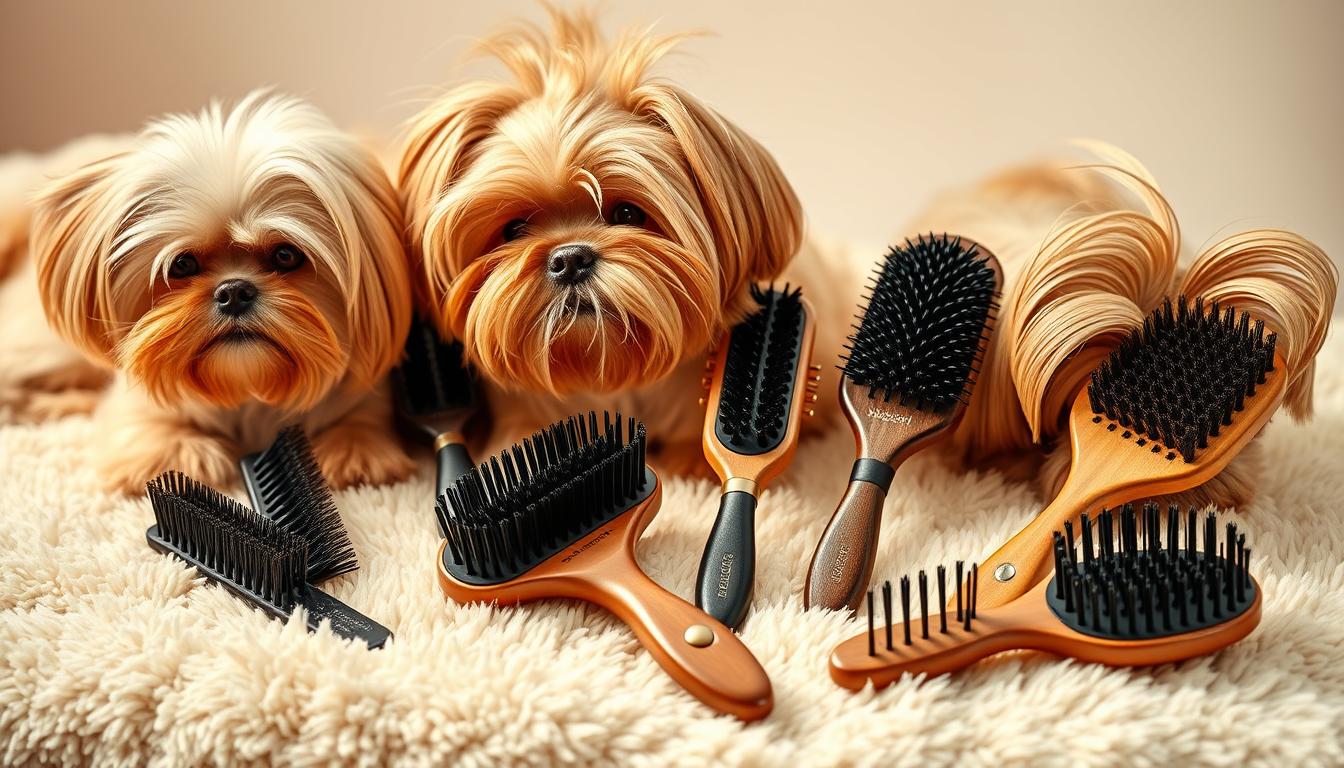As a dog owner, finding the right brushes for long-haired toy dogs can be tough. There are so many choices, it’s hard to pick the best one. I’ve tried many grooming tools for small dogs and I’m excited to share my favorites.
Choosing the right brushes is key for your dog’s coat health and happiness. Regular grooming with the right tools can prevent mats and tangles. This reduces the chance of skin problems and infections. In this article, I’ll talk about the best brushes for long-haired toy dogs, including my top picks for small dogs.
I’ll share my experience with different brushes, like slicker and pin brushes. I’ll also give tips on how to pick the best one for your dog. Whether you’re a seasoned dog owner or new to the scene, this article will guide you. It will help you find the perfect brushes for long-haired toy dogs and make grooming fun for both you and your dog.
Why Choosing the Right Brush Matters

As a dog owner, I’ve learned that picking the right brush for my long-haired toy dog is key. Regular grooming keeps their coat healthy and prevents mats and tangles. It also cuts down on shedding and spreads natural oils evenly.
Choosing the wrong brush can harm your dog’s coat. It might cause breakage, split ends, or even skin problems. That’s why it’s important to invest in quality grooming tools for long-haired toys. We’ll look at how the right brush can make a big difference.
Benefits of Regular Grooming
- Prevents matting and tangling
- Reduces shedding
- Distributes natural oils throughout the coat
How Brush Choice Affects Coat Health
The right brush is crucial for your dog’s coat health. Look for brushes made for long-haired toy dogs. Consider the bristle type, size, and comfort.
Common Issues with Mistakenly Choosing Brushes
Choosing the wrong brush can cause problems like breakage and skin irritation. To avoid these, pick a brush that fits your dog’s coat type and needs.
Types of Brushes for Long-Haired Toy Dogs

As a dog owner, I’ve learned that choosing the right brush for my long-haired toy dog is crucial. It’s important for their coat health and overall well-being. There are many types of brushes, making it hard to choose. I’ll talk about the best brushes for long-haired toy dogs, like top brushes for small fluffy dogs and dog brush for toy breeds.
When grooming my dog, I pick a brush based on their coat type. Slicker brushes are good for removing tangles and mats. Pin brushes are better for detangling and smoothing the coat. Bristle brushes help distribute natural oils and promote healthy skin.
Benefits of Each Brush Type
- Slicker brushes: ideal for removing tangles and mats, suitable for top brushes for small fluffy dogs
- Pin brushes: great for detangling and smoothing out the coat, suitable for dog brush for toy breeds
- Bristle brushes: perfect for distributing natural oils and promoting healthy skin
In conclusion, picking the right brush for your long-haired toy dog is key for their coat health. By looking at different brushes, like top brushes for small fluffy dogs and dog brush for toy breeds, you can choose well. This keeps your dog’s coat looking great.
| Brush Type | Benefits | Suitable For |
|---|---|---|
| Slicker Brushes | Removing tangles and mats | Top brushes for small fluffy dogs |
| Pin Brushes | Detangling and smoothing out the coat | Dog brush for toy breeds |
| Bristle Brushes | Distributing natural oils and promoting healthy skin | All coat types |
Key Features to Look for in a Dog Brush

Choosing the right brush is key for grooming long-haired toy dogs. As a dog owner, I know the right tools are essential. They keep my pet’s coat healthy and clean. We’ll look at important features like ergonomic handles, bristle quality, and size.
For the best brushes for toy dog coats, consider these factors:
- Ergonomic handles for comfort and ease
- Bristle quality and type for effectiveness
- Size and weight for easy use
By focusing on these features, you can find the perfect brush for your dog. Grooming is vital for dog care. The right tools make a big difference in your pet’s happiness and health.
Whether you’re new or experienced in dog care, knowing about grooming is crucial. It helps you choose the right brush for your pet. By picking the best brushes, you ensure your dog gets the best care.
| Brush Type | Features | Benefits |
|---|---|---|
| Slicker Brush | Ergonomic handle, fine teeth | Effective for detangling, reducing shedding |
| Pin Brush | Soft pins, comfortable grip | Gentle on coats, ideal for everyday use |
| Bristle Brush | Natural bristles, durable construction | Suitable for coats with mats or tangles |
My Personal Favorites for Long-Haired Toy Dogs
I’ve tried many brushes on my long-haired toy dog. I’m excited to share my top picks. The right brush makes grooming easier for them. I’ll talk about my favorite brushes, including slicker, pin, and luxury brushes.
I’ve tried many brushes and picked the best. For detangling, a slicker brush is great. It prevents matting and tangling, which hurts my dog. A pin brush is also good and is more affordable.
- Ergonomic handle for comfortable grip
- High-quality bristles that are gentle on my dog’s coat
- Size and weight that are suitable for my dog’s breed and size
I love a luxury brush for grooming. It’s worth the money because of its quality and comfort. Whether you need brushes for small long-haired dogs or toy dogs, I’ve got you covered.
| Brush Type | Features | Price |
|---|---|---|
| Slicker Brush | Detangling, anti-matting | $15-$30 |
| Pin Brush | Affordable, gentle on coat | $10-$25 |
| Luxury Brush | High-quality bristles, ergonomic handle | $50-$100 |
Maintenance Tips for Your Dog Brushes
To keep your dog grooming supplies in top shape, regular care is key. As a dog owner, I know how vital it is to use the right tools to avoid matting. Taking good care of these tools helps them last longer and work better.
Cleaning your dog brushes often is a must to stop dirt and oil buildup. You can wash them with mild soap and warm water. Make sure to dry them well to avoid damage from moisture.
- Store your dog brushes in a cool, dry place to prevent damage from heat or moisture.
- Avoid sharing dog brushes between dogs to prevent the transfer of dirt, oil, and debris.
- Replace your dog brushes regularly to ensure they continue to perform well and prevent matting and tangling.
By following these easy tips, you can make your dog brushes last longer. Always pick the right grooming tools for small dogs. This keeps your dog’s coat clean and healthy.
| Brush Type | Cleaning Frequency | Replacement Interval |
|---|---|---|
| Slicker Brush | After each use | Every 6-12 months |
| Pin Brush | After each use | Every 12-18 months |
| Bristle Brush | After each use | Every 12-18 months |
Grooming Techniques for Long-Haired Toy Dogs
Keeping your long-haired toy dog’s coat looking great needs careful grooming. Start by brushing your pup in sections. This way, you can check and untangle each part thoroughly. Make sure to brush gently to avoid hurting your dog’s delicate hair.
Being consistent with grooming is crucial for long-haired toy breeds. Spend a few minutes brushing your dog every day or every other day. This keeps their coat healthy and makes grooming a pleasant experience for both of you. Always be patient and gentle when grooming your long-haired toy dog.

